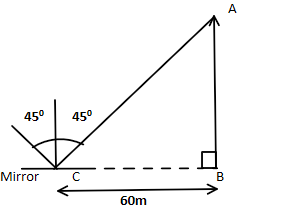
A plane mirror is placed on level ground at a distance $60m$ from the foot of a tower, the ray coming from the top of the tower and its reflected ray from the mirror subtends an angle $90^\circ $. What is the height of the tower?
A) $30m$
B) $60m$
C) $90m$
D) $120m$
Answer
219.3k+ views
Hint:When a plane mirror reflects a ray of light, the angle of reflection is always equal to the angle of incidence. The ray of incidence, reflection and the normal all lie on the same plane. This principle will help us solve the problem in hand. If an incident ray subtends a certain angle then this means that that angle represents the sum of both reflected angle and incident angle.
Complete step by step solution:
Let’s first analyse the scenario. The mirror is at a distance of $60m$ from the foot of the tower.
The incident ray from the top of the tower will hit the mirror to subtend an angle of $90^\circ $. This means that when the incident ray, coming from the tip of the tower hits the mirror it creates a $45^\circ $ angle with the normal and the angle of reflection is $45^\circ $. This is because reflection is based on the principle that angle of reflection is equal to the angle of incidence.
Let’s look at the following figure for better understanding.

From the figure we can see that in the right angled triangle $\vartriangle ABC$ the value of angle $\angle C$ is $45^\circ $.
This implies that the right-angled triangle is an isosceles triangle too. So the lengths of arms $\overline {AB} $ and $\overline {BC} $ are equal.
So the height of the tower will be $\left| {\overline {AB} } \right| = \left| {\overline {BC} } \right| = 60m$
Thus our correct answer is option (B).
Note:Any kind of reflecting surface works on the principle that angle of incidence is equal to angle of reflection. In some cases we might need to use trigonometric calculations in order to find an angle or length of an arm.
Complete step by step solution:
Let’s first analyse the scenario. The mirror is at a distance of $60m$ from the foot of the tower.
The incident ray from the top of the tower will hit the mirror to subtend an angle of $90^\circ $. This means that when the incident ray, coming from the tip of the tower hits the mirror it creates a $45^\circ $ angle with the normal and the angle of reflection is $45^\circ $. This is because reflection is based on the principle that angle of reflection is equal to the angle of incidence.
Let’s look at the following figure for better understanding.

From the figure we can see that in the right angled triangle $\vartriangle ABC$ the value of angle $\angle C$ is $45^\circ $.
This implies that the right-angled triangle is an isosceles triangle too. So the lengths of arms $\overline {AB} $ and $\overline {BC} $ are equal.
So the height of the tower will be $\left| {\overline {AB} } \right| = \left| {\overline {BC} } \right| = 60m$
Thus our correct answer is option (B).
Note:Any kind of reflecting surface works on the principle that angle of incidence is equal to angle of reflection. In some cases we might need to use trigonometric calculations in order to find an angle or length of an arm.
Recently Updated Pages
A square frame of side 10 cm and a long straight wire class 12 physics JEE_Main

The work done in slowly moving an electron of charge class 12 physics JEE_Main

Two identical charged spheres suspended from a common class 12 physics JEE_Main

According to Bohrs theory the timeaveraged magnetic class 12 physics JEE_Main

ill in the blanks Pure tungsten has A Low resistivity class 12 physics JEE_Main

The value of the resistor RS needed in the DC voltage class 12 physics JEE_Main

Trending doubts
JEE Main 2026: Application Form Open, Exam Dates, Syllabus, Eligibility & Question Papers

Understanding Uniform Acceleration in Physics

Derivation of Equation of Trajectory Explained for Students

Hybridisation in Chemistry – Concept, Types & Applications

Understanding the Angle of Deviation in a Prism

Understanding Collisions: Types and Examples for Students

Other Pages
JEE Advanced Marks vs Ranks 2025: Understanding Category-wise Qualifying Marks and Previous Year Cut-offs

Understanding Atomic Structure for Beginners

How to Convert a Galvanometer into an Ammeter or Voltmeter

Understanding Centrifugal Force in Physics

JEE Main Marking Scheme 2026- Paper-Wise Marks Distribution and Negative Marking Details

Degree of Dissociation: Meaning, Formula, Calculation & Uses




